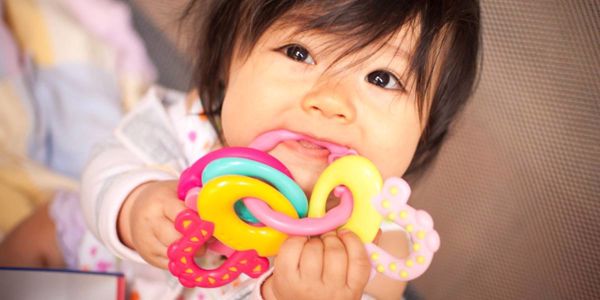From around 10-11 weeks in utero, your baby’s tooth buds start to appear, but don’t actually break through the gums until they’re around 6-months old after birth. The lower teeth erupt first, with the final top teeth coming through around 20 months later. When exactly your baby will start to teethe is difficult to predict, as all babies develop at different rates. However, there are a number of ‘symptoms’ or signs that suggest it may be happening soon.
Teething Symptoms
- Dribbling
- Chin or face rash
- Coughing
- Biting
- Pain or irritability
- Fussiness when feeding
- Diarrhoea
- Elevated temperature
- Difficulty sleeping
- Rubbing their cheeks/pulling on their ears
Some babies breeze through their teething stage with not much bother, others have a hard time with it and it can be quite distressing seeing your baby in such discomfort.
When Will My Baby’s Teeth Come Through?
Your baby’s teeth will come through at different times, typically the bottom front teeth arrive first, followed by the top front teeth, giving them that adorable buck-toothed smile, but the rest will fill their grin soon enough.
Here’s the general, approximate order and time frame you should expect to see their teeth grow:
6 to 10-months - central incisor (bottom front)
8 to 12-months - central incisor (top front)
9 to 13-months - lateral incisor (top font)
10 to 16-months - lateral incisor (bottom front)
13 to 19-months - first molar (top)
14 to 18-months - first molar (bottom)
16 to 22-months - canine (top)
17 to 23-months - canine (bottom)
23 to 31-months - second molar (top)
25 to 33-months - second molar (bottom)
How to Soothe a Teething Baby
When our babies cry, we just want to take their pain away and hold them close. Teething is one of those long, drawn-out stages every child goes through, and it can be a distressing time for both you and baby, but there are some ways to alleviate some of that discomfort for baby and give your ears a little break between cries.
- Give them something to chew on. Teethers that have been put in the fridge or freezer until cold (but not solid) are great for babies to chew on/gum. The coldness helps soothe the gums and can help stimulate growth as they chew.
- Give them your hand. They’ll be chewing on their hand most of the time during this stage, but sometimes a bigger hand and fingers can be a lot more soothing. Wash your hand thoroughly (and trim your nails) and use it to firmly massage your baby’s gums. They’ll likely bite down, but it really does help them.
- Give them some paracetamol. In some instances, teethers and hands just won’t cut it and you need to crack out the painkillers. Once your baby is over 3-months old, you can give them baby paracetamol or baby ibuprofen to relieve their pain. Any teething gels are best left until you’ve consulted your GP due to their ingredients, however, there are also some more natural home remedies that can help.
- Chamomile is a natural anti-inflammatory, so you can dip a clean flannel in some chamomile tea and pop it in the freezer (not until its solid) for your baby to suck on, or even keep it warm to room temperature for a more warm, soothing soak.
- Chilling a teething toy can also provide additional relief, but again, don't freeze it solid, as that will make it too hard for your baby's teeth and gums. If the item was in the freezer, be sure to let it thaw partially before giving it to your baby.





